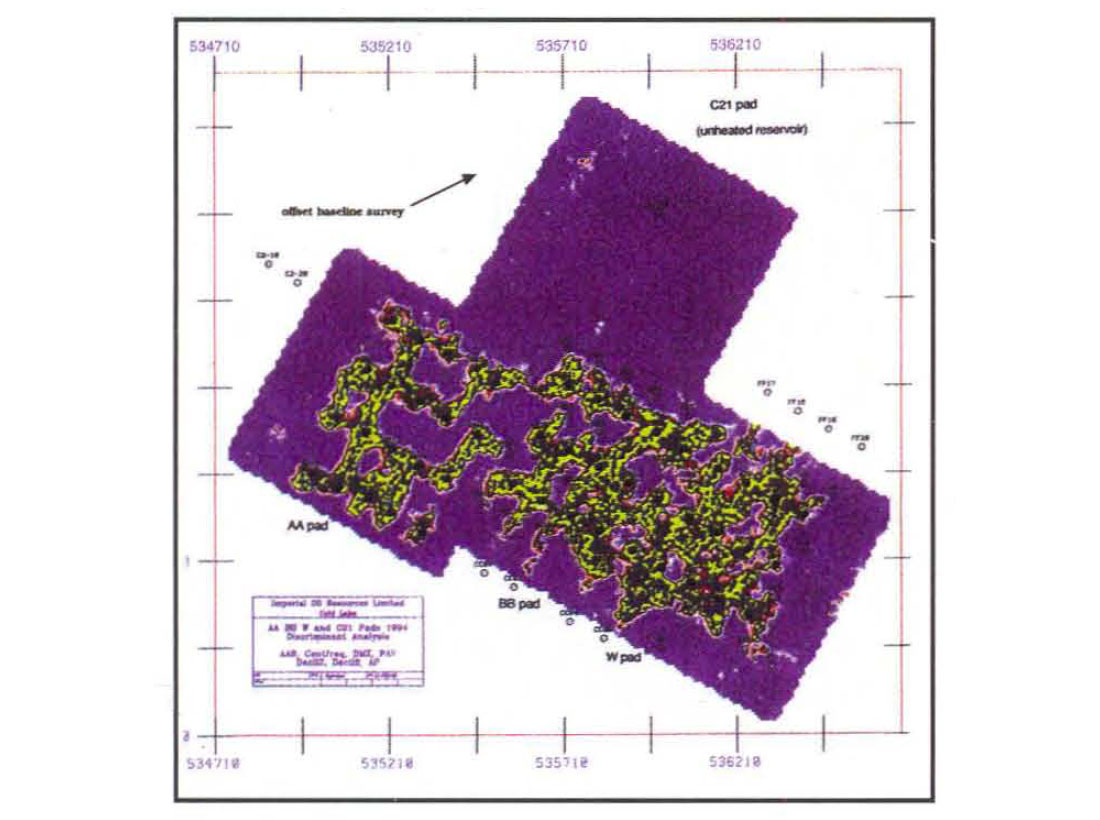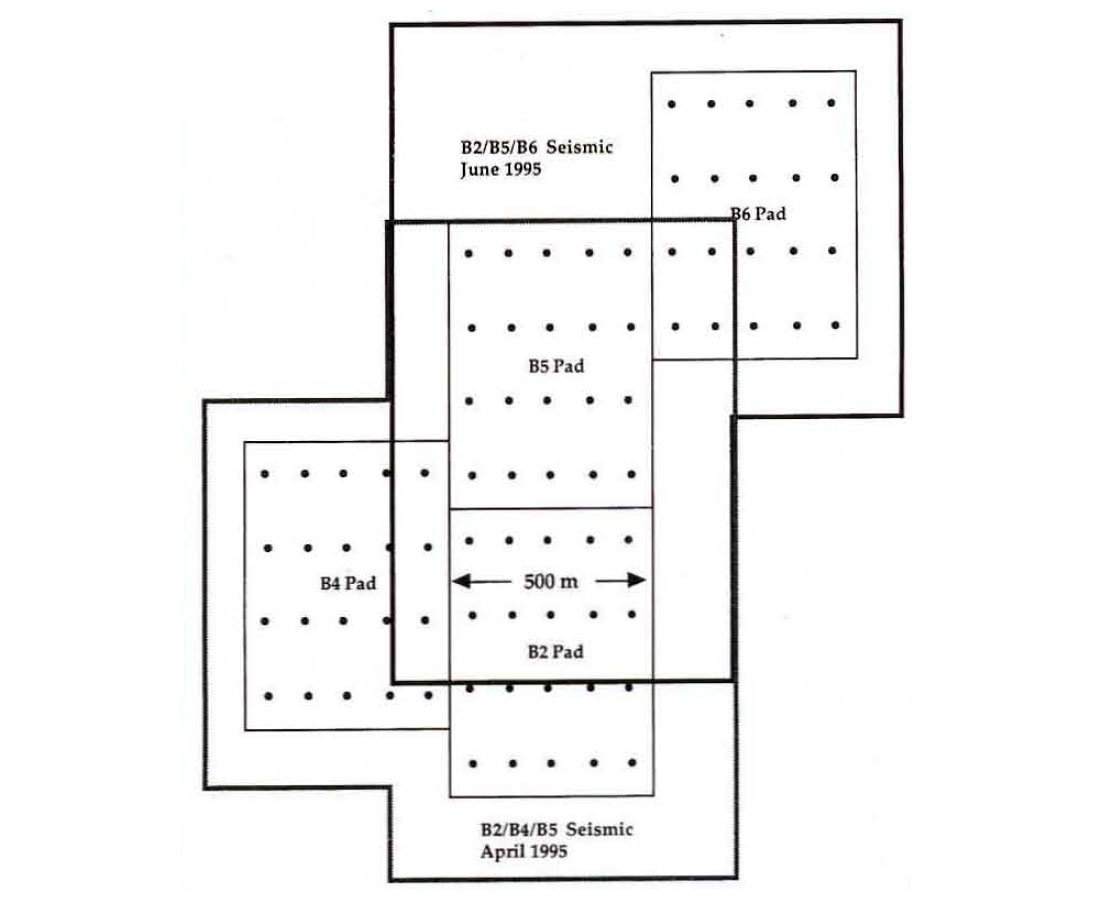Summary
A technique is illustrated which uses a single 3D seismic monitor survey along with multiple seismic attributes in conjunction with an offset baseline survey to discriminate heated reservoir from unheated reservoir. 3D seismic monitoring has definitively mapped steam heated regions of the reservoir at two separate geographic locations encompassing more than 150 wells in Cold Lake. Based on these maps, infill wells have been drilled into those regions of the reservoir which have remained unheated after ten years of steam injection.
Introduction
The classical approach for seismic monitoring involves the acquisition of a baseline survey (prior to reservoir engineering intervention) and subsequent monitoring surveys which use the baseline survey as the frame of reference (Greaves and Fulp, 1988). At Cold Lake, the calendar time separation of 10 years between the onset of CSS (Cyclic Steam Stimulation) and the engineering need to evaluate conformance (reservoir sweep) has precluded the collection of a baseline survey. In particular, there are 2000 CSS wells in Cold Lake which are currently being operated and for which no baseline 3D seismic monitor survey exists.
In the past at Cold Lake, 3D time lapse seismic data has been acquired at different reservoir conditions; nominally, during steam injection (high pressure and temperature) and oil production (low pressure and moderate temperature with gas present) to provide two different reservoir states to image heated reservoir and hopefully enhance the interpretation (Eastwood et aI., 1994). This previous study at Cold Lake indicated that although there is a strong seismic response to heat for oil sands (Wang and Nur, 1989) that the more important mechanism for the observed seismic response at Cold Lake is gas exsolution (methane and carbon dioxide) which is associated with the heated reservoir.
Part 1: Technique for Single Survey Seismic Fluid Monitoring
Seismic monitoring at AA/BBIW pads (~2 sq. km) utilized our conventional approach with a steam injection seismic survey in 1993 and a bitumen production survey in 1994. A CSS pad (500 m x 680 m) encompasses 20 wells at a 4 acre spacing. However, the most important upgrade to the conventional approach was to acquire 3D seismic data adjacent to the CSS pads in an area which has no CSS wells, and therefore has not been heated ('offset baseline survey'). By exploiting seismic attributes the seismic characteristics of the offset baseline survey (cold reservoir) were contrasted to the seismic characteristics at the CSS pads near the injection wells (steam stimulated reservoir).
The main objective of this work was to map the spatial distribution of the heated reservoir, so interval attributes were calculated through the entire reservoir. To determine the suite of seismic attributes best suited to mapping conformance the following criteria were used. Rock physics work (both theory and experiment) showed that seismic attributes which are sensitive to amplitude anomalies and time sag associated with a decrease in acoustic impedance and velocity should be used and previous experience with seismic monitoring at Cold Lake suggested the use of spectral attributes to capture changes in frequency content. All attributes from the amplitude and spectral basis which correlated with known reservoir hot spots (injection wells) and cold spots (a random sample from the offset baseline survey) were evaluated.
Redundant attributes which had high spatial correlations were eliminated.
Seven interval attributes were chosen for the discriminant analysis. Statistical analysis indicated that four principal components provided 95% of the information contained in the seven attributes. Cluster analysis (no calibration), also indicated a natural separation of the heated reservoir and the unheated reservoir. Based on the discriminant analysis, 99% of the calibration points in the unheated reservoir (offset baseline survey), and 97% of the calibration points at the injection wells (5 nearest seismic traces to each of 50 wells) were classified correctly. The output from the discriminant analysis includes for every x-y location the probability of belonging to one class or the other (Figure 1). From the discriminant classification of AAIBBIW pads areal conformance (fraction of heated reservoir) can be calculated by simply integrating the area within an isovalue (0.5 is a natural choice).

In order to test the robustness and accuracy of the seismic image the following tests were performed:
- 3D data processed independently by two seismic processing companies. Identical quantitative analysis applied to each volume.
- Sensitivity analysis to attribute selection and calibration points (number and location).
These tests indicated that the seismic images were accurate and robust relative to the engineering objectives. The reservoir engineering objective was to contrast the seismic prediction of heat conformance for AA pad with BB and W pads (Figure 1). AA pad has 20 CSS wells with the conventional well spacing, in contrast BB and W pads were infill drilled to a 2 acre spacing in 1988. The seismic data indicates that the heated fraction of the reservoir has increased as a result of infill drilling.
Part II: Case History, Drilling 46 wells based on Seismic Monitoring at Cold Lake
The seismic monitoring at AA/BB/W pads was a hind cast in terms of reconciling production results with reservoir state for AA pad compared to BB and W pads (infill pads). However, the seismic image of AA pad indicated that there was a significant fraction of the reservoir (45%) which had not been accessed by CSS in 10 years. A proposal was tabled to infill drill AA pad based on the seismic image, however, the infill drilling of AA pad has been delayed for another steam cycle (3 years). To further advance, the technology and reduce uncertainty regarding the merits of infill drilling mature CSS pads another site was chosen.
Two 3D seismic surveys were acquired over four Cyclic Steam Stimulation (CSS) pads in Cold Lake in 1995. Discriminant analysis with seven seismic attributes was used to map the steam heated zones in the reservoir. The survey was shot over two acquisition dates to ensure that reservoir pressures were between 2-3 MPa which is required for the best correlation between seismic anomalies and heated reservoir. The first survey encompassed the southern 3/4 of the project and the second survey encompassed the northern 1/2 of the project (Figure 2).

Based on the image 46 infill wells were drilled from Oct. - Dec. 1995 on two of the pads. The other two pads will continue to be operated as CSS pads so that production data can be contrasted to the infill well pads. Of the 46 wells, the majority were targeted for zones in the reservoir which were imaged by the seismic to be cold. However, several wells were targeted for hot zones and several wells were targeted for transition zones which served the purpose of validating the seismic images and increasing the understanding of bitumen (oil) depletion in the reservoir (Figure 3).

Resistivity, SP, gamma ray, and temperature logs were obtained on all the infill wells. Neutron porosity, density, and sonic logs were obtained on a subset set of the wells, and a few select wells were also cored. The log response for the original wells (CSS wells - 10 year old logs at original reservoir conditions) and the new infill wells were analyzed jointly to calculate changes in oil saturations for each of the infill wells relative to the original conditions. Temperature and oil saturation changes for the infill wells are summarized in Figures 4 and 5.
Conclusions
By combining multiple seismic attributes via discriminant analysis, a single 3D monitor survey (including an offset baseline survey) can successfully delineate heated reservoir. The 3D seismic and subsequent well drilling and logging show that -45% of the reservoir has not been accessed by steam throughout 10 years. The average temperature of the reservoir which is imaged by the seismic as unheated is 22 C, while the temperature of the heated reservoir is 150 - 200 C based on References: the CSS well data.

Acknowledgements
The following staff at TOL made significant technical contributions to this analysis: Seismic Acquisition: Rick Bailey, Zig Doborzynski, Leslie Cassidy; Seismic Processing: Scott Mcgrew; Reservoir Engineering: John Elliott, Darryl Youck.










Join the Conversation
Interested in starting, or contributing to a conversation about an article or issue of the RECORDER? Join our CSEG LinkedIn Group.
Share This Article